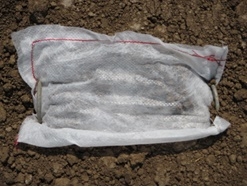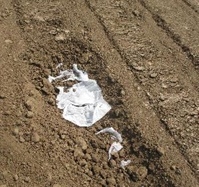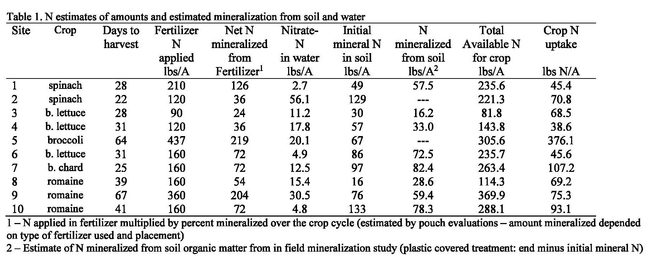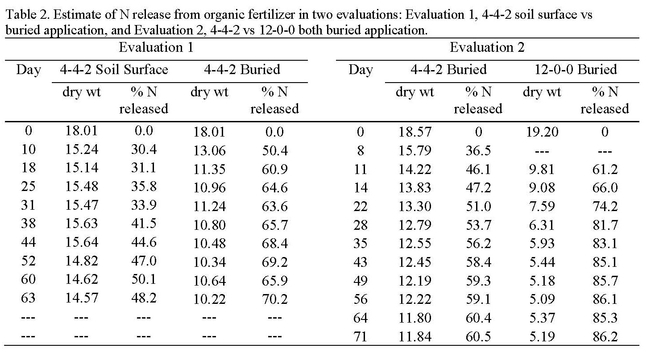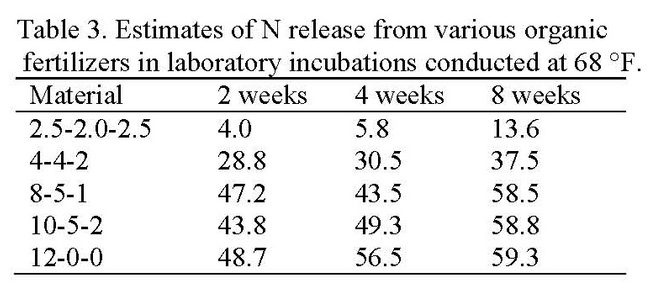Organic production in Monterey County was valued at $335 million in 2015, which was 7% of total agricultural value. Organic agriculture has a prominent role in Monterey County agriculture, but many aspects of organic production are still poorly understood and are in need of more research. The transformations of nitrogen (N) that occur in soil, and organic amendments and fertilizers that ultimately produce plant available forms of nitrogen (nitrate and ammonium, a.k.a. mineral nitrogen) are only understood in a general way. In 2016 we received funding from the Fertilizer Research and Education Program (FREP) which is funded by a mil tax on fertilizer sales, including organic fertilizers, to evaluate nitrogen mineralization (release of mineral nitrogen from soil organic matter) from soils on organic farms and from organic fertilizers. Evaluations included determination of the mineralization of soil organic matter over the course of the cropping cycle of baby vegetables and full-term romaine. In addition, evaluations were conducted of mineralization of organic fertilizers in production fields as well as laboratory incubations carried out at UC, Davis.
Evaluations of soil organic matter
Ten N mineralization trials were conducted in the Salinas Valley with cooperating growers in commercial production fields in diverse locations and with a spectrum of soil types. Field evaluations consisted of establishing replicated unfertilized areas in each field. Within each unfertilized plot, we had areas with and without plants, as well as an area covered with plastic mulch; these areas allowed us to estimate the amount of N mineralized from soil organic matter without the confounding factors of crop uptake and leaching. Unfertilized areas were compared with adjacent fertilized plots. The amount of N mineralized in field evaluations ranged from 0.6 to 3.3 lbs N/A/day; more N mineralization generally occurred in soils with greater quantities of total N in the soil. Nitrate-N at the beginning of the cropping cycle was a useful indication of the amount of N available for crop growth during the crop cycle (Figure 1). Not surprisingly, the sites with low levels of soil nitrate at the start of the crop cycle had greater responses to applied fertilizer. Initial soil nitrate levels would be a great tool for organic growers to utilize to help guide fertilizer decisions, however from these data it is clear that it is not precise enough to fully guide fertilizer decisions except for when levels are extremely high or extremely low. The fields that had initial soil nitrate-N levels of 75-125 lbs N/A had 15-30% greater yield with applied nitrogen fertilizer, even though N uptake by crops was modest for all crops except broccoli. One reason measurements of initial residual soil nitrate levels may not be as good of a predictor of crop response to N might be due to inefficiencies in irrigation management which could result in movement of N beyond the root zone. Water used to germinate the crop or set transplants often exceeds the ability of the soil to retain it, resulting in nitrate leaching at the beginning of the crop cycle. Measuring residual soil nitrate after the germination water applications could improve the estimates of available residual soil nitrate. However, the fast crop cycle of the baby vegetables, necessitates making fertilizer decisions early in the crop cycle.
The nitrate levels in the irrigation water in the surveyed sites was low to moderate and did not contribute large amounts of N to the crop budget (Table 1). Mineralization of N from the soil organic matter over the course of the crop cycle was also low to moderate in the surveyed sites. All the crops surveyed in these evaluations have rapid N uptake patterns in the last half of the crop cycle. It is at this time when robust quantities of N are needed to supply the crop with the amounts of N needed to maximize yields (Figures 2 and 3). The N release pattern of organic fertilizers is another factor that makes N management of organic crops difficult.
Evaluations of organic fertilizers
Organic fertilizers used in the production of cool season vegetables are either incorporated into the soil or applied to the top of the beds and sprinkled in. Based on these application methods, field evaluations of organic fertilizer were made by placing organic fertilizers in pouches (See photos below) and applying them to the soil in two ways: 1) buried 3 inches deep to simulate incorporated applications and 2) by placing the pouches on the soil surface to simulate surface (a.k.a. drop-on-top) applications. Pouch evaluations were conducted in commercial production fields and placed in the field at the beginning of the crop cycle. Three to four pouches were collected weekly and the contents were dried, weighed and analyzed for N, phosphorus (P) and potassium (K); the rate of disappearance of nutrients from the pouches estimated the rate of plant-availability. Organic fertilizers used were 4-4-2 (chicken, meat and bone meal) and 12-0-0 (feather meal). Evaluation 1 was a placement evaluation of 4-4-2 (buried vs surface applied). In this trial, 4-4-2 that was buried in the soil released mineral N more quickly and released more N than surface applications, 48.2 and 70.2%, respectively (Table 2). Evaluation 2 was a comparison of 4-4-2 and 12-0-0, both buried in the soil at the beginning of the crop cycle of a broccolini field that was in the ground for 71 days. 12-0-0 released N more quickly and released more mineral N than 4-4-2, 86.2 and 60.5%, respectively.
These evaluations show a rapid release of N from the organic fertilizer over the first 2 to 3 weeks after application. After that time, the rate of release of N is very slow. Burying the material increased the rate of N release; fertilizer with a higher N concentration showed faster N release. It is possible that the pouch evaluations overestimate the N release rate because of movement of small particles of fertilizer that filter out of the pouch; this idea is supported by observations in a laboratory evaluation conducted at Davis that showed about a 20-30% lower rate of N release of 4-4-2 and 12-0-0 over the same period of time (Table 3).
The amount of N applied as fertilizer ranged from 1.2 to 4.8 times crop N uptake (Table 1). However, discounting the amount of N that actually mineralizes from the organic fertilizer, organic fertilizer applications in this survey ranged from 0.4 to 2.7 times crop N uptake.
Soil P values at each survey site were relatively modest for the Salinas Valley vegetable ground, except for one that was located on an old dairy. Bicarbonate extractable P values ranged from 10 to 57 ppm with a mean of 37 ppm (excluding the old dairy site with a bicarbonate P value of 112 ppm). The moderate P values occurred in spite of the common usage of 4-4-2 which has a ratio of 1:1 of N:P2O5. The form of P in 4-4-2 fertilizer comes mostly from bone meal, which is not soluble at soil pH greater than 7.0; all survey sites had pH above 7.0, meaning that bone meal is a highly inefficient P source in this production system. In fertilizer pouch Evaluation 1, phosphorus release was 17% after 63 days in both surface and buried applications. Based on this survey, it appears that soil bicarbonate extractable P levels do not rise rapidly due to the use of 4-4-2. By contrast 82 to 92% of the K contained in 4-4-2 was rapidly released to the soil after 63 days in Evaluation 1.
Summary
Organic fertilization of fast-maturing cool season vegetables is complicated by a number of factors:
- The difficulty of utilizing residual soil nitrate monitoring, given the potential for nitrate leaching with these heavily irrigated, shallowly rooted crops
- Uncertain rates of N release from organic fertilizers due to the variable effects of temperature, fertilizer placement and fertilizer N concentration
- Difficulty synchronizing N release from soil and organic fertilizers with the high crop N demand over the last half of the crop cycle
These studies provided some evidence that measurements of residual soil nitrate can provide a useful tool for planning fertilizer programs in some situations. However, even soils with robust amounts of residual soil nitrate-N (100 – 125 lbs N/A) may still benefit from fertilizer in spite of mineralization of N from soil organic matter and nitrate in the irrigation water, and clearly more study is needed to better understand this issue. The release of N by organic fertilizer is affected by placement, N concentration of the material and temperature and this study provide some measurements of those effects. The fate of N not released from organic fertilizer after the crop cycle is not well understood, but presumably it becomes available to future crops, mineralizing at a slow, steady rate similar to soil organic matter. The high usage of 4-4-2 which is a mix of chicken manure blended with meat and bone meal on larger-scale organic farms brings the benefits of adding significant amounts of organic matter to ranches that may not have extensive cover crop or compost programs. However, use of 2-3,000 lbs 4-4-2 per crop 2-3 times per season adds 2-4.5 tons of carbon-rich organic matter to the soil. Measurements of P release from 4-4-2 indicate that the 1:1 ratio of N:P2O5 does not appear to be resulting in high levels of bicarbonate extractable P buildup in the soils surveyed in this study.
